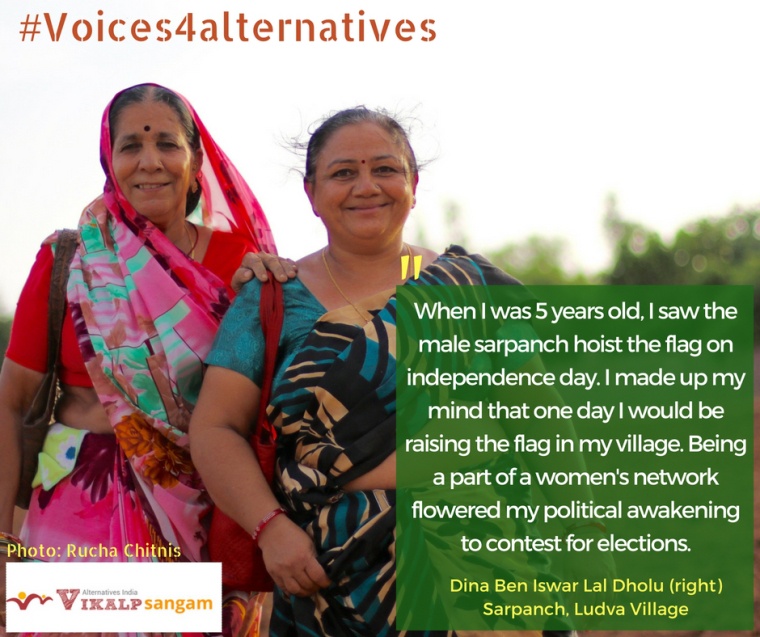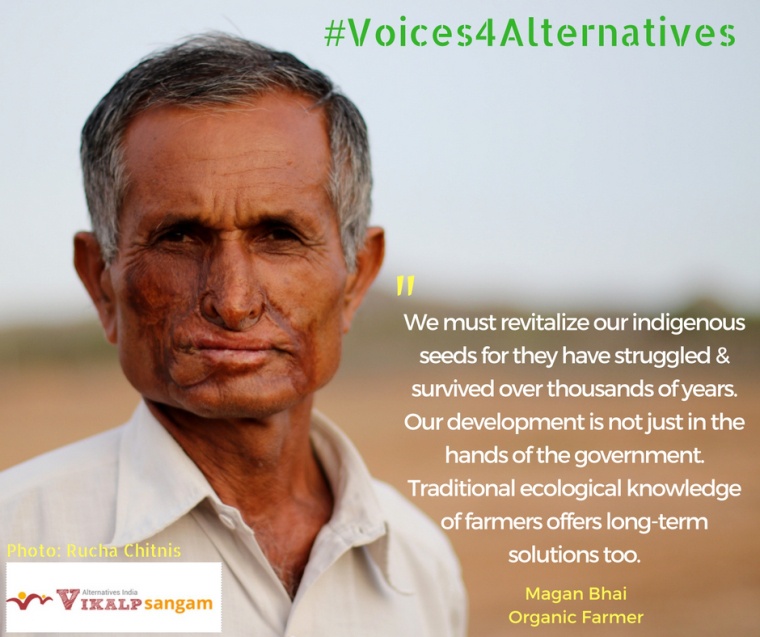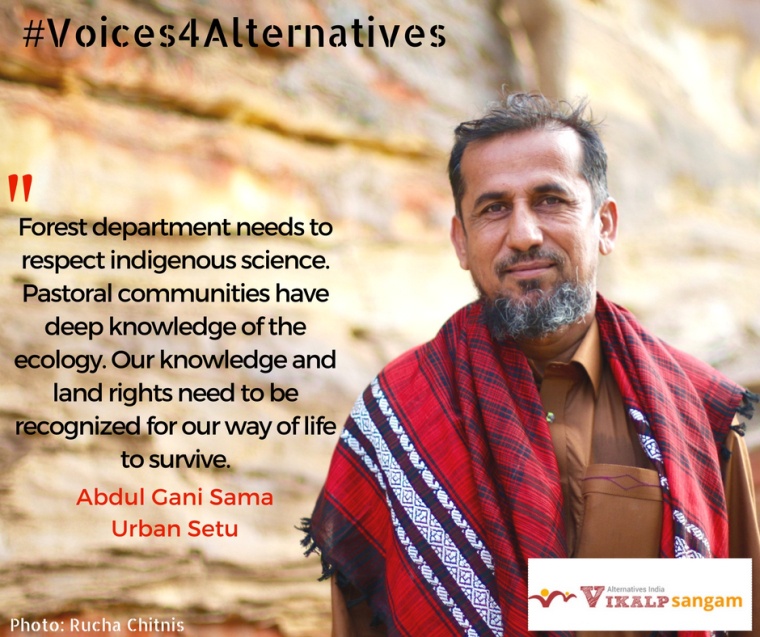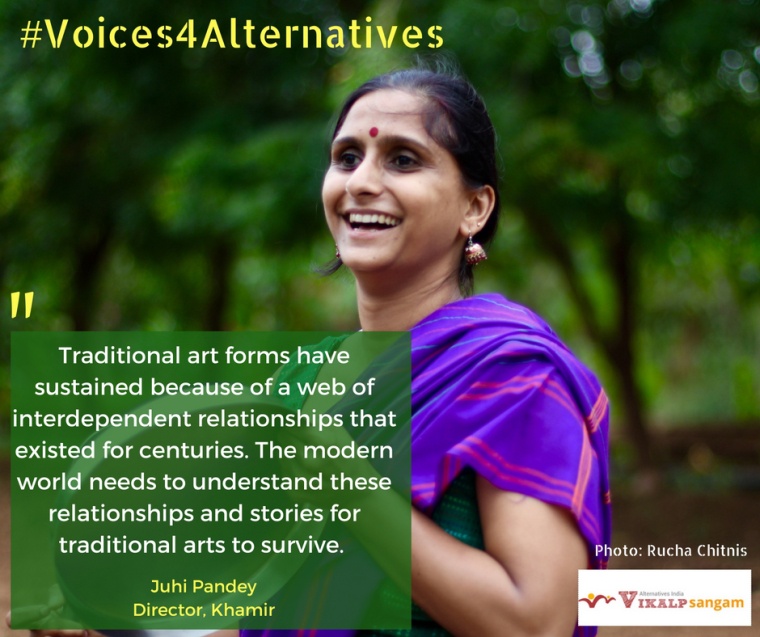The ancient roots of Kachchh trace to the Bronze Age, where ruins of a Harappan city were found in Dholavira. Kachchh is considered as the cradle of craftsmanship, where an old world meets the new in a tenuous grasp to preserve ancient arts and traditional livelihoods. The Kachchh convening of VikalpSangam, a platform for collaborating on grounded alternatives at a time of growing inequities and ecological woes, illustrated a rich confluence of possibilities and viable solutions, when ancestral knowledge and appropriate innovations are harnessed by the creativity and wisdom of farmers, pastoral communities, artisans and grassroots groups.
#Voices4Alternatives is the anchoring hashtag to spotlight these grassroots voices and faces that are seeding and amplifying ecological alternatives to promote dignified livelihoods, sustainable agriculture and traditional arts in Kachchh and beyond. Here are some of the powerful takeaways of the Sangam, and how people-powered alternatives are igniting hope in India’s largest district.
1) Women are in the Heart of Alternatives
As a young girl, Dina Ben noticed that the male sarpanch (village head) would customarily hoist the flag on Independence Day. “As a young girl I had this burning dream that one day I would raise the flag in my village,” she said. “Later I became busy raising children and managing a home. I had no knowledge about the panchayat.” Dina Ben joined KachchhMahilaVikasSanghatan (KMVS), a group that holistically empowers the leadership of rural women in social, economic and political spheres of their lives.
Participating in KMVS trainings led to the political awakening of Dina Ben and gave her the courage to contest for elections. “When women stay at home, they say we are inexperienced. When we come out of the home, we are defamed by society and face character assassination,” she shared. Fortunately for Dina Ben, her family was supportive and the backing of the women’s networks gave her the strength to persevere. “Because I fought for people’s rights and entitlements, I won the election in 2011 by 51 votes,” she beamed. The KachchhSangam also highlighted the vital role of women in amplifying alternatives–from fighting land grabs to advocating for the rights of pastoral communities and
rural women.
2) Looking at the Earth
Beyond Materialism
“Nature is not just a resource but our mother who sustains us,” said Magan Bhai, an organic farmer, who joined the Sangam to share alternatives on sustainable agriculture. Magan Bhai, who has been farming ecologically for 16 years, poetically reminded us that the relationship of farmers with the soil, seeds and the Earth has deep spiritual and cultural resonance. “We depend on the government or the West for solutions. But what about the knowledge of farmers? For thousands of years, our seeds have survived and adapted by farmer innovations. Let’s not forget that,” he said. “Today farmers feel helpless and lost, because we want short cuts and have stopped using our own intelligence.”
3) Networks Foster Collective Liberation
The KachchhSangam brought to life the rich web of networks of grassroots groups. Recognizing that working in silos was business as usual, Kutch NavNirmanAbhiyan,a collective of 22 groups with a strong local presence, was founded after a devastating cyclone struck in 1998. Abhiyan harnesses the potential of local knowledge and physical and financial resources to develop Kachchh as a region that is governed by community initiatives. Abhiyan also seeded Urban Setu, an initiative to build a robust urban citizenry to hold local government agencies accountable through participation and advocacy.
Abdul GaniSama, a maldhari (pastoralist) who is actively connected to the Setu networks, shared how he is advocating for quality education for vulnerable children in rural communities in Khavda through consciousness-raising efforts and outreach. Abdul also shared that his community is fighting for the recognition of grazing rights of pastoral communities that were compromised after the Forest Department seized the land. “We have been here since the seventh century. We are using the Forest Rights Act to fight for our grazing lands. Our knowledge about the land and ecology needs to be respected by the government,” he shared.
4) Reciprocity, Not Money, Sustained Artisan Communities
As the cradle of craftsmanship, the KachchhSangam illuminated the dazzling abundance of traditional art forms that have been preserved for centuries. The Sangam highlighted the power of reciprocal relationships that were sustained by farmers, pastoral communities, weavers, block printers and other artisans. “Money was not traditionally exchanged,” said VankarShamjiVishram, an artisan hailing from a multi-generational family of weavers from Bhujodi. Juhi Pandey, Director of Khamir, a nonprofit that promotes the crafts, heritage and cultural ecology of Kachchh, concurred. “There was a robust barter system before currency came into play. Communities were inter-dependent and weaving thrived because of this inter-dependency,” she said. “The modern world needs to understand these relationships and stories for traditional arts to survive.”
5) Old World Crops are the Fabric of Identity
ShivramShabhuram Pandya is the director of AadesarVistarKhetUtpadan Producer Company Limited, a farmer-driven company that advocates for dignified livelihoods of small producers. Shivram shared about their initiative to revitalize the production of Kala Cotton, an old world cotton that was nearly destroyed by industrialization and mechanization. Weaving kala cotton is not an easy feat; it requires great skill and patience. Groups like Khamir are encouraging sustainable Kala Cotton production to preserve livelihoods of farmers and artisans. Farmers, like Shivram, also exemplified how old world crops, like Kala Cotton, form the fabric of identity of communities in Kachchh. Preserving traditional crops also promotes traditional arts and artisans, who are grappling with cultural survival in the face of staggering pressures of modernization.
The KachchhSangam exemplified how a web of connected activism and grassroots voices are amplifying alternatives from preserving traditional arts to promoting the livelihoods of artisans to advocating for the rights of pastoral and farming communities. Groups like Sahjeevan, Hunnarshala, Arid Communities and Technologies and KachchhQasab and Arts, among others, are on the forefront building bridges to make ancient arts and livelihoods relevant in a modern world.














